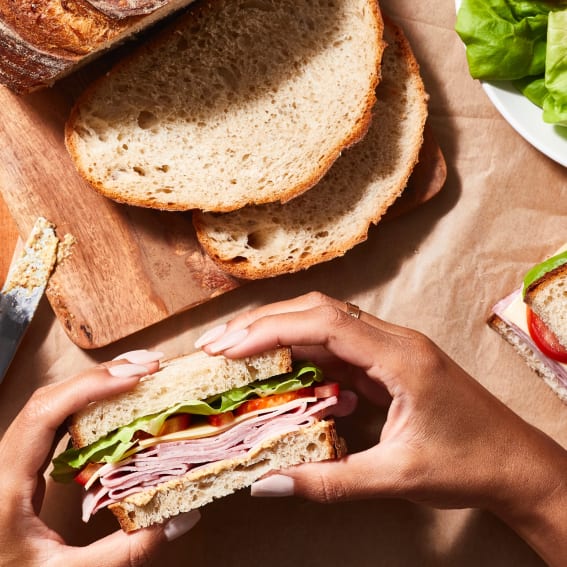Yeasted Nearly No-Knead Bread

Andrew Janjigian
September 14, 2023
This is an easy, long-fermented rustic yeasted loaf with great flavor for minimal effort, with a crisp crust and a holey, irregular crumb. It uses bread flour with the addition of 10% whole wheat flour for a boost of wheaty flavor and a tan-hued crumb.
To develop gluten without kneading, it relies on a long fermentation, along with a brief 20-minute rest before the salt is added, a trick known as an autolyse, and a single set of folds early on. The shaped loaf gets placed in a banneton or a towel-lined colander and is then proofed in the refrigerator for 8 to 24 hours, where it develops flavor and firms up to encourage clean, dramatic slashes upon baking.
This recipe yields one 900g loaf.
Serves
8
Prep Time
00:20
Cook Time
00:50

4.75 (4)
2057
Ingredients
360 g (1 1/2 cups)
cool (75˚F) water
1 g (1/4 teaspoon)
instant yeast
455 g (3 1/4 cups)
bread flour
56 g (1/2 cup)
whole wheat flour
11 g (1 1/2 teaspoons)
fine salt
Steps
1. Make Dough and Autolyse
Place all but 1 tablespoon of the water in a large bowl, add the yeast, and whisk to combine. Add the flours and stir with a wooden spoon or by hand until combined and no dry flour remains, 1 to 2 minutes. Cover loosely with plastic wrap or a plate and let sit for 20 minutes.
2. Add Salt and Rest Dough
Add the salt and remaining water to the top of the dough. Knead by hand until the salt is incorporated and the dough is even in texture, 1 to 2 minutes. (It will remain slightly shaggy.) Cover loosely with plastic wrap or a plate and let sit for 30 minutes.
3. Fold Dough
Using lightly-moistened hands, fold the dough over itself by gently lifting and folding the edge of the dough toward the middle. Turn the bowl 90 degrees; fold again. Turn the bowl and fold the dough 4 more times (a total of 6 turns).
4. Bulk Proof
Rack
Cover bowl tightly with plastic wrap and set in a moderately warm place (70˚ to 75˚F) until expanded in volume by about 1 1/2 times, 6 to 8 hours. (If you can’t find a suitable spot, you can always use your Anova oven.)
Sous Vide Mode: Off
Steam: Off
Temp: 77°F
Heat: Bottom
06:00 Timer
5. Preshape Loaf
Using lightly-moistened hands, knead the dough gently in the bowl to deflate it and shape it into a round at the bottom of the bowl. Cover loosely with plastic wrap or a plate and let sit for 20 minutes.
6. Shape Loaf
Using a spatula or dough scraper, gently turn the dough ball out of the bowl onto a lightly-floured counter. Gently press the dough into an 8-inch disk, then the fold the edges toward the middle to form a round, pinching the seams closed as necessary. Set the dough ball on its side, with the seams pointing to either side. Roll the seams under your palms to seal and stretch them into a short 'tail'.
Liberally flour a banneton or linen towel-lined colander with white rice flour. Set the loaf into the proofing basket and fold the corners of the towel over the loaf, if using.
7. Proof Loaf
Place the proofing container in a large plastic bag and tie or fold under to fully enclose. Let rest at room temperature for 30 minutes, then refrigerate for 8 to 24 hours.
8. Preheat the Oven
Rack
When you’re ready to bake, place a baking steel, baking stone, or cast iron skillet in the oven and turn it on.
Sous Vide Mode: Off
Steam: Off
Temp: 482°F
Heat: Rear
9. Preheat Baking Surface
Rack
This automatic stage ensures the baking surface is fully preheated.
Sous Vide Mode: Off
Steam: Off
Temp: 482°F
Heat: Rear
00:15 Timer
10. Steam Oven
Rack
This stage fills the oven with steam before loading the loaf.
Sous Vide Mode: Off
Steam: 100%
Temp: 482°F
Heat: Rear
00:02 Timer
11. Score Loaf
While the oven steams, invert the loaf onto the center of a 12- by 12-inch sheet of parchment paper. Holding a razor blade or sharp knife at a 30-degree angle to the loaf, make a series of four 4-inch long, 1/4-inch deep slashes to form a square around perimeter of loaf, about 2 inches in from the edge of the loaf.
12. Insert Loaf
Rack
Place the parchment-lined loaf on the center of a pizza peel and transfer to the baking steel.
Sous Vide Mode: Off
Steam: 100%
Temp: 356°F
Heat: Bottom
13. Steam Loaf
Rack
Start the timer to steam the loaf for the first 5 minutes of baking.
Sous Vide Mode: Off
Steam: 100%
Temp: 356°F
Heat: Bottom
00:05 Timer
14. Bake Loaf
Rack
The oven will automatically turn off the steam to let it dissipate.
Sous Vide Mode: Off
Steam: Off
Temp: 356°F
Heat: Bottom
00:30 Timer
15. Brown Loaf
Rack
Let the oven adjust automatically to a high heat cook with the rear heating element to brown and firm the crust.
Sous Vide Mode: Off
Steam: Off
Temp: 424.994°F
Heat: Rear
00:15 Timer
16. Continue Browning (If Needed)
Rack
Check the loaf for browning. If needed, return it to the oven and continue to cook the until desired color is achieved.
Sous Vide Mode: Off
Steam: Off
Temp: 424.994°F
Heat: Rear
00:10 Timer
17. Cool and Serve
Remove the loaf from the oven and transfer it to a cooling rack. Let cool for at least 3 hours before slicing and serving. The bread will keep, enclosed in a paper bag (or set cut-side down on a cutting board) for up to 3 days. If you’d like, you can refresh the bread using the recipe for Reheating Stale Bread.
© 2013 - 2025 Anova Applied Electronics, Inc.